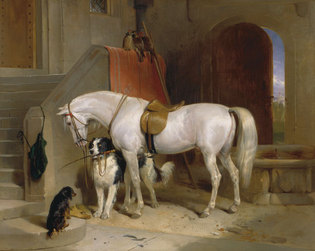 loading
loading
Arts & CultureBefore Will and Kate and baby GeorgeAnimal companions of an earlier Prince George of Cambridge. Angus Trumble is the Senior Curator of Paintings and Sculpture at the Yale Center for British Art.  Yale Center For British Art/Paul Mellon CollectionThis painting, left to the Center for British Art by Paul Mellon ’29, was owned by the Prince George who lived from 1819 to 1904. View full imageTwo months ago the Duke and Duchess of Cambridge announced amid much global fanfare that their baby son—third in the line of succession to the British throne and that of 15 other Commonwealth countries—will formally be known as His Royal Highness Prince George of Cambridge. By coincidence, there is in the collection of the Yale Center for British Art a splendid oil painting by Sir Edwin Landseer (1802–73) entitled Favourites, the Property of HRH Prince George of Cambridge (1834–35). This Prince George of Cambridge (1819–1904), who was 14 or 15 years old in 1834, was the only son of Adolphus, Duke of Cambridge (1774–1850), himself the tenth child and seventh son of King George III and Queen Charlotte. Though Prince George is represented here only in the form of a riding glove carelessly abandoned on the bottom step in the foreground, this painting portrays the teenage prince’s pony, his dogs, and his hooded falcons, with Windsor Castle just visible through the open door. His black-and-white Newfoundland hound takes charge of the reins and riding crop, pending his energetic young master’s return. At his birth in 1819, Prince George was the only surviving grandson of the old king and was therefore of some dynastic importance. In 1830, he was sent to live at Windsor Castle with his childless uncle and aunt, the new King William IV and Queen Adelaide. William and Adelaide seem to have toyed with the idea that their niece and heir apparent, the young Princess Victoria, might eventually be persuaded to fall in love with Prince George, but she resisted with considerable firmness. Because she was first in line for the throne, William’s death in 1837 launched the Victorian era rather than another Georgian one. Through the 1840s and 1850s, as Queen Victoria produced heirs with impressive regularity, Prince George’s place in the line of succession descended, notch by accelerating notch. At the same time, he rose steadily through the ranks of the British army, becoming commander-in-chief in 1856. He served in that capacity for an unprecedented 39 years. This painting must have retained considerable sentimental value to Prince George, because it hung in his official residence until his death in March 1904, nearly 70 years after it was completed.
The comment period has expired.
|
|